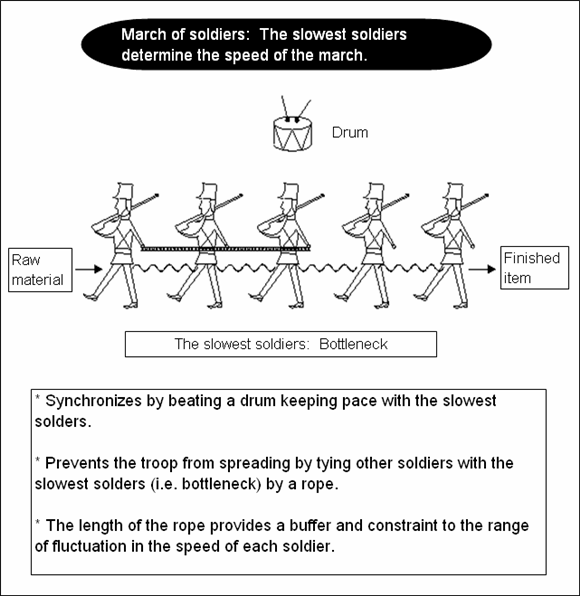DBR (Drum Buffer Rope) Theory
2008.05.15
Metaphoric example to understand the flow of a supply chain. A concept of increasing throughput by adjusting buffers by a rope and controlling speed by a drum.
Like members of a mountaineering team who climb a mountain on the rope, a drum and rope are used for an analogy of management tools when soldiers march or boy scouts hike.
This troop analogy was first applied to a production line by Ford Motor Co., Ltd. who connected production processes of an automobile assembly line by conveyer belts. Then, Mr. Taiichi Ohno of Toyota Motor Corporation introduced a rope called "KANBAN". Both of the concepts brought an innovation in company management and had a great impact on economic growth.
As in an example of boy scouts hiking, those who are bottlenecks are positioned at the beginning and a rope is used for subordinating (synchronizing) the speed of followers with that of the bottleneck persons. This enables preventing the march (work-in-process inventory) from expanding. In other words, to eliminate work-in-process inventory is to reduce costs. Also, in preventing the front ones of the bottleneck group who determine the marching speed of the entire team from slowing down, a rope plays an important role as a buffer to absorb the changes in the marching speed of the front ones of the bottleneck group. A drum plays a role of conveying the information about the speed of the slowest bottleneck persons to everyone in the group and cheering up the bottleneck persons to raise their speed up.
When the rope is stretched out to the limit, it is necessary to impose a constraint on those who tied to the rope so that they will not be able to raise the speed any further. In some cases, work needs to suspend when the buffer reaches the limit. Similarly, the team may sometimes need to stop. If the drum is beaten at the speed of the first person of the team, an interval with the following persons will get wider and wider. In that case, the inventory level will increase and throughput will decrease. If the drum is beaten at the speed of the last person of the team, i.e. the team marches at the speed of the inventory, the inventory level will decrease and throughput will increase as the speed of demand increases. The pull-type system means to beat a drum at the speed of the last person, which corresponds to as demand-driven pull type supply chain management.

Taken with kind permission from the book:
"Understand Supply Chain Management through 100 words" by Zenjiro Imaoka.
Published by KOUGYOUCHOUSAKAI
